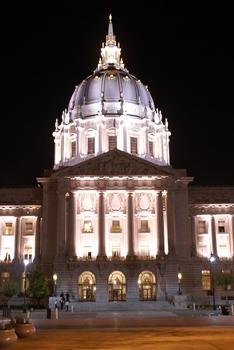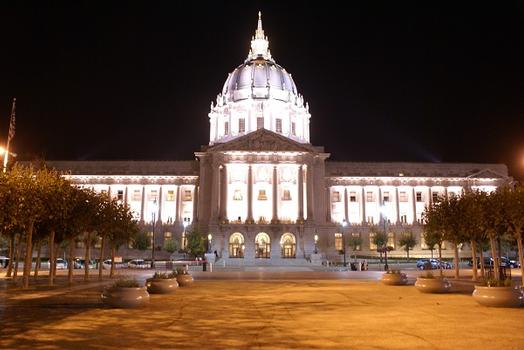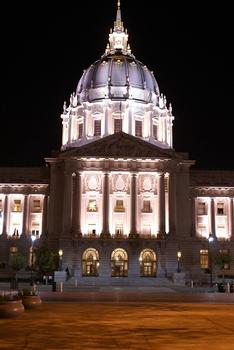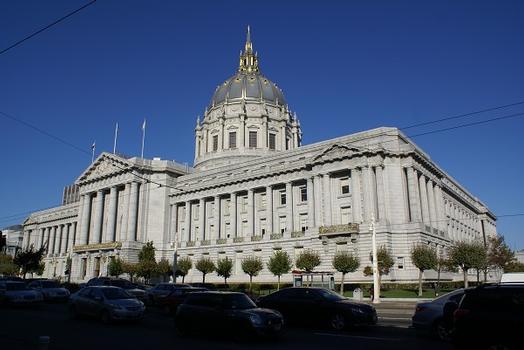General Information
Project Type
| Structure: |
Dome |
|---|---|
| Function / usage: |
City or town hall |
Location
| Location: |
San Francisco, San Francisco County, California, USA |
|---|---|
| Address: | 400 Van Ness Avenue |
| Coordinates: | 37° 46' 45.32" N 122° 25' 9.91" W |
Technical Information
Dimensions
| dome | diameter | 27.43 m |
Cost
| cost of construction | United States dollar 3 499 262 |
Chronology
| March 1912 | San Francisco voters approve an $8.8 million bond issue to build a new City Hall by a margin of 11-to-one. Architectural analysis proves that Old City Hall was well-built on a firm foundation, but couldn't withstand the seismic forces of the 06 quake. A competition for the new City Hall is announced, limited to architects registered to practice in California with offices in San Francisco. |
|---|---|
| 20 June 1912 | The winning design for the new City Hall is announced, by Arthur Brown, Jr. of the firm Bakewell and Brown. Browns design references the dome of the Church of Les Invalides in Paris. |
| 5 April 1913 | Groundbreaking by Mayor Sunny "Jim" Rolph. |
| 25 October 1913 | Mayor Rolph lays the cornerstone. |
| 28 December 1915 | City Hall is dedicated by Mayor Rolph. |
| 9 October 1916 | First meeting held in City Hall chambers. |
| 2 August 1923 | Following a trip to Alaska, President Warren G. Harding dies of pneumonia at the Palace Hotel on Market Street. The Presidents body lies in state in the Rotunda of City Hall. |
| 1934 | James "Sunny Jim" Rolph dies while serving as governor of California. His body lies in state in the magnificent City Hall that he sponsored. |
| 14 January 1954 | Joe DiMaggio and Marilyn Monroe are married in San Francisco City Hall. |
| April 1978 | Special award from the American Institute of Architects. |
| 10 October 1978 | Designated a National Historic Landmark District, with City Hall listed as a Contributor Building. |
| 27 November 1978 | Mayor George Moscone and Supervisor Harvey Milk are assassinated in their chambers at City Hall by former Supervisor Dan White, who avoids security precautions by climbing in through a basement window. |
| 17 October 1989 | Loma Prieta earthquake of magnitude 7.1 subjects City Hall to peak ground acceleration of up to .10 gravity forces. Significant earthquake motion lasts for about 8 seconds. The dome twists on its steel frame like a cap on a bottle, moving two inches. Cracks in the walls and concrete floor slabs occur at all levels. The 1913-era seismic resistance system is damaged; the dome cracks, large patches of plaster fall. City architects determine that the building will not collapse in another earthquake, but that future damage will not be repairable unless the buildings capacity to resist a major temblors lateral forces is repaired. |
| June 1990 | San Francisco voters pass a $332.4 million general obligation bond for repair and seismic retrofitting of 191 city buildings damaged in the Loma Prieta earthquake, including City Hall. |
| November 1995 | San Francisco voters approve a $63.5 million general obligation bond issue for funding for additional improvements to City Hall. |
| 13 February 1998 | A fire starts 60 meters above ground after welders leave the wooden substructure of the dome smoldering. Damage is quickly repaired, and the entire dome is resurfaced. |
| 5 January 1999 | Re-opening for civic and public use. |
Notes
Modeled after Saint Peter's in Vatican City (Rome), the dome stands taller than the United States Capitol in Washington, D.C.
Participants
Relevant Web Sites
- About this
data sheet - Structure-ID
20009318 - Published on:
26/05/2003 - Last updated on:
06/03/2022












